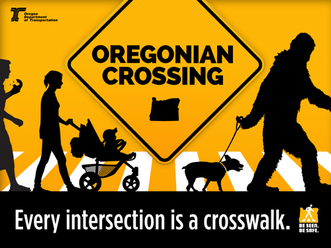 It’s the time of year to make New Year’s resolutions – resolving to change bad habits, start a new healthy activity, or volunteer in your community. As 2015 comes to a close and Oregon traffic fatalities climb, consider adopting a new resolution to make 2016 a safer year for everyone on our roads. Resolutions can be powerful and if we can put them into practice every day, we can actually save lives and prevent tragedies.
- I resolve to obey the speed limit. Excessive speed is a factor in many crashes and the most common one in crashes that result in fatalities.
-
I resolve not to drive, walk, or ride impaired. Alcohol, illegal drugs, and even some legal drugs can reduce the ability to use good judgment.
-
I resolve to buckle up on every trip, every time. Safety belts and child safety seats are the biggest contributors to saving lives in crashes.
-
I resolve to be alert – pay attention to the complex task of driving – and avoid texting or talking on my cell phone while driving.
|
Driving at night is more difficult because visibility is reduced.
However, low visibility conditions often occur during the day, caused by heavy
snowfall, downpours, thick fog, and blowing dust or smoke. Follow these safety
tips for driving in low visibility conditions:
- Slow down. Disengage your cruise control. Most accidents occur because the driver is going too fast for the weather conditions.
-
Use your low beams. High beams will disperse in thick fog or snow,
making visibility worse for you and other drivers.
-
Turn on your rear fog lamps, if your vehicle is equipped. They
greatly aid visibility for drivers approaching from the rear.
-
Avoid entering an area if you cannot see a safe distance ahead.
-
If you suddenly encounter a severe loss of visibility, pull off
the pavement as far as possible. Stop, turn off your lights, set the emergency
brake and take your foot off the brake to be sure the taillights are not
illuminated. Turn on your emergency flashers.
-
If you can't pull off the roadway, slow down, turn on your low
beam headlights and sound the horn occasionally. Use the white fog line or
roadside reflectors if necessary to help guide you.
-
Never stop in the travel lanes.
Be seen: Use headlights in winter!
Turning on your low-beam headlights during the daytime in the
winter months can help make your vehicle more visible to other drivers,
bicyclists and pedestrians.
When natural light is low — at dawn or dusk or when it’s raining,
cloudy, or snowing — you can improve your vehicle’s visibility significantly by
turning on your low-beam headlights. In fact, many newer vehicles come with
daytime running lights so that anytime the vehicle is operating, the low-beam
headlights are on to improve visibility.

The U.S. National Highway Traffic Safety Administration has
released a fact sheet that estimates the number of lives saved resulting from
the use of seat belts, child restraints, and motorcycle helmets, and
minimum-drinking-age laws in 2014. More (PDF 125KB)
ODOT is offering Pedestrian
Safety Enforcement mini-grants to law enforcement agencies to help educate drivers about Oregon crosswalk laws. In these operations, a decoy police officer
attempts to cross a street at an intersection crosswalk. If passing motorists
fail to stop and stay stopped for the pedestrian, they are issued a warning or
a citation. The operations include a media outreach component with the purpose
of raising awareness.
Under Oregon law (ORS 811.028) every intersection is a legal
crosswalk. You must stop for people showing intent to cross the street at a
marked or unmarked crosswalk or at a marked mid-block crosswalk.
The application deadline for mini-grants is January 15. Application and
training information can be found on the Oregon Impact website. Training will be held on March 7, 2016 in Eugene and the training is open to all enforcement agencies, whether or not applying for the mini-grant.

|